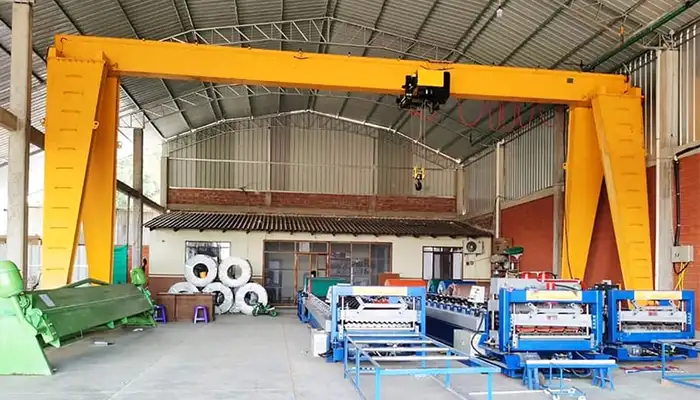
Choose the Right 15 Ton Gantry Crane for Workshop & Yard
How to Choose the Right 15 Ton Gantry Crane for Your Workshop or Yard
Gantry cranes are essential tools in workshops and outdoor yards. They allow heavy loads to be lifted, moved, and positioned with ease, without relying on permanent overhead structures. Whether you’re handling steel plates, machinery parts, or large materials, a gantry crane can make everyday operations safer and more efficient.
Choosing the right crane is not just about capacity. The wrong type or size can lead to frequent breakdowns, slow workflow, and higher costs over time. Understanding your needs, the workspace, and the crane’s specifications is key to getting a solution that works reliably for years.
For many workshops and yards, a 15-ton gantry crane hits the sweet spot. It provides enough lifting power for medium-heavy loads while remaining manageable for installation and operation. This capacity is popular because it can handle a wide range of tasks without requiring specialized infrastructure.
Why a 15-ton gantry crane works for most buyers:
- Flexible lifting across indoor workshops or outdoor yards.
- Balances lifting power and operational ease.
- Reduces long-term maintenance costs when properly chosen.
- Ideal for medium-heavy materials like steel, machinery, and bundled loads.
Step 1: Understand Your Lifting Requirements
Before choosing a 15 ton gantry crane, it’s crucial to understand exactly what you need the crane to do. Getting this right ensures safety, efficiency, and long-term reliability. Both workshop and outdoor gantry cranes have different considerations, so let’s break it down.
Load Weight and Frequency
Knowing the weight of your materials is the first step. For a 15-ton crane, confirm both the maximum load it will ever lift and the typical load during daily operations.
- Occasional heavy lifts may allow for lighter-duty components, but frequent heavy lifting requires a crane built for continuous operation.
- Overloading or near-capacity lifts repeatedly can shorten the crane’s lifespan and increase maintenance.
- Typical workshop applications include steel plates, machinery parts, or medium-sized fabricated components.
Lifting Height
The crane’s hook height should match your workspace.
- In workshops, consider ceiling height, overhead pipes, lighting, and other obstructions.
- For outdoor gantry cranes, account for vehicle clearance, stacking heights, and uneven ground.
- A 15-ton gantry crane often handles mid-height lifting tasks, like moving large pallets, containers, or machinery modules.
Span and Coverage
The crane span is the distance between the legs of the gantry, and it determines how much of your workspace the crane can cover.
- Measure your workshop or yard width carefully.
- Decide if you need full coverage of the workspace or just a specific lifting lane.
- Outdoor applications may require longer spans to cover loading areas, storage yards, or material staging zones.
Operating Environment
Your crane’s environment affects design, materials, and protective features.
- Indoor workshop gantry cranes usually face controlled temperatures and smooth concrete floors. Corrosion is less of a concern.
- Outdoor gantry cranes need weatherproofing, anti-corrosion coatings, and sometimes reinforced wheels for uneven surfaces.
- Check ground conditions: smooth concrete, asphalt, or slightly uneven terrain can all affect wheel design and stability.
Typical Applications and Industries for 15-Ton Gantry Cranes:
- Steel processing and fabrication workshops.
- Machinery manufacturing and assembly plants.
- Shipping yards and container handling.
- Material storage and warehouse operations.
- Outdoor construction sites and medium-scale industrial yards.
Step 2: Know the Main Gantry Crane Types
After understanding your lifting needs, the next step is to choose the right type of 15 ton gantry crane for your workshop or yard. The type of crane affects cost, performance, and suitability for your specific operations. Let’s look at the three most common types and where they are typically applied.
Single Girder Gantry Crane
Single girder gantry cranes have one main beam with the hoist traveling along it. This design is simple, lightweight, and ideal for workshop gantry cranes where space and lifting height are moderate.

15 ton gantry crane single girder design for indoor use , tailored workshop gantry crane for sale
Typical Applications:
- Small to medium manufacturing workshops.
- Material handling of steel plates, machinery components, and fabricated parts.
- Light-duty assembly or maintenance operations.
Advantages for 15 Ton Capacity:
- Lower cost while still capable of lifting medium-heavy loads.
- Easier to install and maintain in workshops.
- Suitable for occasional or moderate lifting frequency.
Limitations:
- Limited span and lifting height compared to double girder cranes.
- Not ideal for continuous heavy-duty operations or very large items.
Double Girder Gantry Crane
Double girder gantry cranes have two main beams, providing additional strength and stability. For a 15 ton gantry crane, this type is popular in both workshops and outdoor yards where lifting frequency and span requirements are higher.

double girder gantry crane for outdoor use , tailored outdoor gantry cranes
Typical Applications:
- Steel fabrication and processing plants.
- Machinery assembly and industrial workshops.
- Outdoor yards handling pallets, containers, or heavy modules.
Advantages:
- Handles frequent lifting and heavier loads reliably.
- Offers higher stability and safety for medium-heavy industrial operations.
- Can cover longer spans in both workshop and outdoor settings.
Limitations:
- Higher cost and more complex installation than single girder cranes.
- Requires more maintenance attention, especially in outdoor conditions.
Truss Gantry Crane
Truss gantry cranes use a truss structure for the main girder, reducing weight while maintaining strength. This type is particularly suitable for outdoor 15 ton gantry cranes in industrial yards or facilities with very long spans.
Typical Applications:
- Outdoor storage yards and container handling.
- Steel mills or construction sites with extended lifting lanes.
- Handling bulky or awkward materials where a standard girder may sag.
Advantages:
- Lightweight but strong for long spans.
- Ideal for outdoor operations with medium-heavy loads like steel coils, large machinery, or pre-fabricated components.
- Durable and reliable for demanding industrial environments.
Limitations:
- Higher initial investment.
- More engineering and design work required.
Practical Tip
Selecting the right crane type ensures your 15 ton gantry crane operates efficiently and safely in its intended environment. Consider the following guidelines:
- Indoor Workshop Gantry Cranes: Single and double girder cranes are the most common and efficient choices.
- Outdoor 15 Ton Gantry Cranes or Long-Span Yards: Truss gantry cranes are preferred for extended spans and heavy-duty outdoor lifting.
- Always match the crane type to operational needs, lifting frequency, and industrial sector to achieve maximum safety and efficiency.
Step 3: Determine Hoist Type and Travel Mechanism
Choosing the right hoist and travel mechanism is one of the most important steps for a 15 ton gantry crane. It affects safety, lifting efficiency, and how well the crane performs in either a workshop or outdoor yard. Below is a practical breakdown of your options.
Hoist Type: Wire Rope vs. Chain
The hoist is the heart of your crane. For a 15-ton capacity, the type you choose will determine lifting speed, load handling, and durability.
Wire Rope Hoists: Wire rope hoists are designed for medium-heavy loads and repetitive lifting. They are durable and suitable for long lifts.
- Typical applications: steel fabrication plants, machinery assembly workshops, outdoor storage yards, and construction sites.
- Suitable for both workshop gantry cranes and outdoor gantry cranes.
Chain Hoists: Chain hoists are best for lighter loads and shorter lifts. They are simpler to maintain but not ideal for full-capacity 15-ton lifts.
- Often used in small workshop gantry cranes handling machinery parts or light materials.
- Cost-effective for occasional lifts but not suitable for high-frequency industrial use.
Operation: Manual vs. Electric
The power source impacts how fast and safely your crane operates.
Manual Hoists: Manual operation is simple and low-cost, ideal for infrequent lifting.
- Mostly used in small workshop gantry cranes with occasional load handling.
- Not recommended for continuous operations or heavy-duty industrial sectors.
Electric Hoists: Electric hoists offer faster, safer, and more efficient lifting for repetitive tasks.
- Common in steel mills, heavy machinery workshops, outdoor storage yards, and construction sites.
- Recommended for outdoor gantry cranes handling frequent medium-heavy loads.
Travel Mechanism: Rails vs. Rubber-Tired
How your crane moves affects workflow efficiency and flexibility.
Rails (Wheeled Gantry Cranes): Rails allow precise movement along a set path, perfect for structured production areas.
- Common in workshop gantry cranes and fixed outdoor yards.
- Suitable for repetitive lifting tasks where material flow is predictable.
Rubber-Tired or Movable Gantries: Rubber-tired gantries offer mobility for changing work areas or outdoor yards.
- Ideal for outdoor 15 ton gantry cranes in shipping yards, construction sites, or material storage areas.
- Handles medium-heavy materials such as steel coils, machinery components, or modular equipment.
Key Takeaways
Choosing the right hoist and travel system is critical for your 15 ton gantry crane. Consider the operating environment and lifting requirements to maximize efficiency, safety, and flexibility:
- Workshops: An electric wire rope hoist on rails is efficient, precise, and safe for indoor operations.
- Outdoor Yards: An electric wire rope hoist with rubber-tired travel provides flexibility for changing lifting points and larger areas.
- Always match the hoist and travel system to lifting frequency, load type, and environment for optimal performance.
Step 4: Consider Structural and Safety Features
When choosing a 15 ton gantry crane, the structure and safety features are just as important as lifting capacity. A well-designed crane not only ensures smooth operation but also protects workers and reduces long-term maintenance costs.
Frame Material and Durability
The crane’s frame determines its strength, stability, and suitability for different environments. For workshop gantry cranes, standard steel with proper welding is usually sufficient. For outdoor gantry cranes, additional treatments are necessary to handle weather and corrosion.
- Use high-quality steel grades to support 15-ton loads reliably.
- Anti-corrosion coatings or galvanization are essential for outdoor cranes exposed to rain, humidity, or salty air.
- Durable frames extend crane lifespan and reduce maintenance costs in industrial sectors such as steel mills, construction yards, and machinery workshops.
Safety Features
Safety features protect both operators and the crane itself. Even experienced operators can make mistakes, so built-in protections are critical for 15 ton gantry cranes.
- Overload protection prevents lifting beyond the crane’s rated capacity.
- Emergency stop buttons allow immediate halting in dangerous situations.
- Limit switches stop the hoist at top or bottom travel limits to prevent collisions or damage.
- Compliance with local standards and certifications (CE, ISO) ensures the crane meets regulatory safety requirements.
- Industrial sectors like workshops, outdoor storage yards, and steel processing plants benefit from these features for consistent, safe operations.
Maintenance Accessibility
A crane that is easy to maintain reduces downtime and repair costs. For 15 ton workshop and outdoor gantry cranes, routine inspections and maintenance are unavoidable, so accessibility should be considered during selection.
- Ensure easy access to key components, including hoists, motors, and travel mechanisms.
- Design that allows quick inspection and lubrication saves time and improves safety.
- Regular maintenance is critical in high-frequency industrial sectors, such as steel fabrication, heavy machinery assembly, and shipping yards.
Practical Tip
Whether your 15 ton gantry crane will operate in a workshop or an outdoor yard, paying attention to structural and safety details makes a big difference. Consider these key points to ensure durability, efficiency, and compliance:
- For workshops, focus on steel frame durability, easy access, and built-in safety features.
- For outdoor yards, add anti-corrosion treatment, weather-resistant components, and a reinforced structure.
- Always verify compliance with CE, ISO, or local standards before purchase to ensure the crane is safe and reliable.
Step 5: Evaluate Installation and Operational Factors
Choosing a 15 ton gantry crane requires careful consideration of space, power, scalability, and cost to ensure safe and efficient operation.
- Installation Space: Measure height and width, and check for obstructions like pipes, beams, or machines. Ensure enough clearance for the hoist and trolley. Suitable for both workshop and outdoor gantry cranes.
- Power Supply: Verify voltage, phase, and frequency compatibility. Correct power ensures smooth operation of electric hoists and avoids downtime.
- Future Scalability: Plan for potential upgrades or relocation. Flexible cranes can adapt to expanded workshops, storage yards, or changing workflows.
- Budget vs. Total Cost of Ownership: Consider purchase price, operating cost, maintenance, and lifespan. Investing in a durable crane reduces downtime in steel fabrication, machinery assembly, or outdoor storage yards.
Select a crane that fits your space, matches your power setup, and balances upfront cost with long-term reliability for optimal performance.
Step 6: Compare Suppliers and Customization Options
Selecting the right supplier is just as important as choosing the crane itself. A reliable partner ensures your 15 ton gantry crane meets performance, safety, and operational needs.
- Certifications and Track Record: Verify CE, ISO, or local certifications and review past projects to confirm reliability.
- Customization Options: Ask about tailoring span, lifting height, outdoor protection, and specialized hoists to match your workshop or outdoor yard requirements.
- After-Sales Support: Evaluate technical support, maintenance services, and availability of spare parts for smooth long-term operation.
Tip: A supplier who understands your industrial sector—like steel fabrication, machinery assembly, or storage yards—and offers customization will help maximize efficiency and safety.
Conclusion
Selecting the right 15 ton gantry crane is more than choosing lifting capacity. It’s about matching the crane type, hoist, travel system, and safety features to your specific operational needs. Doing this ensures long-term efficiency, reliability, and safety.
Before moving forward, make sure you have detailed site information:
- Load requirements: Maximum and typical weights.
- Workspace layout: Available height, span, and any obstructions.
- Power supply: Voltage, phase, and location.
- Operational environment: Indoor workshop or outdoor yard conditions.
Key Takeaways
When choosing a 15 ton gantry crane, keeping key factors in mind ensures safety, efficiency, and long-term reliability. Focus on the following points to make a well-informed decision:
- Ensure your crane meets safety standards like CE and ISO, with features such as overload protection and emergency stops.
- Consider long-term efficiency and total cost of ownership, not just the initial price.
- Choose a supplier who offers customization and reliable support to minimize downtime and boost productivity.
- A well-planned purchase makes your workshop or outdoor gantry crane a dependable asset for years.